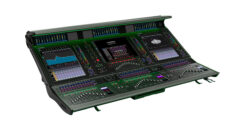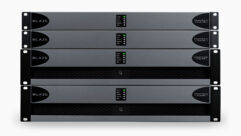A System to Learn fromThree-channel audio gives a college auditorium the flexibility to be both lecture and concert hall.
Feb 20, 1997 12:00 PM,
By Gregory A. DeTogneDeTogne is a free-lance writer based in Libertyville, IL.
Like those in search of ultimate knowledge from a Tibetan guru, facility managers, audio designers, contractors and engineers come from everywhere to Bethel College in Mishawaka, IN, seeking audio enlightenment. It is here where they find one of the country’s economical three-channel L-C-R audio systems.
A small, private Christian college, Bethel had no idea its new multipurpose auditorium would become a model for others to emulate. But indeed it has, attracting the attention of many professionals who think they can learn quite a bit from the design.
Budget talksLike many undertakings of this nature, construction of Bethel’s new auditorium didn’t escape the cold, steely grip of budget realities. The project felt the cash crunch from the moment of inception. In adding the facility to the campus, Bethel president Norm Bridges set out to build a $5 million structure for $3 million. But despite the odds, the structure stands completed, thanks in part to shrewd fiscal management and a number of benefactors.
Truly multipurpose in both form and function, the auditorium building satisfies many student needs. With 900 seats (700 on the main floor and 200 in the balcony), the fan-shaped room is used for chapel services and as a lecture hall, rehearsal space and performing arts center.
Bringing audio to the environment was a task reserved for a Mishawaka-based systems integration and design group called NITECH. Joining NITECH in bringing the project to a successful conclusion were John Szabo, Bethel College’s facility director; John Whitehead of the Troyer Group, the project architect; and Professor Harold P. Geerdes, the acoustical consultant.
“The job began in earnest when the project architect brought me a huge bill of materials,” said Tom Hubbard Jr., NITECH director of sales and marketing. “From that bill of goods, the audio system was born.”
Like a child going over his wish list with Santa, Hubbard went up and down the equipment manifest, contacting manufacturers to locate the necessary components within the confines of a $160,000 budget. But just as the blank spaces on the bill of materials were being filled up with actual model numbers, Hubbard received word that the budget was slashed by $60,000.
Lesser men may have suffered a full-blown anxiety attack, but Hubbard simply sharpened his systems-engineering pencil and accepted the challenge. As with any sound system, one of the costliest items on Hubbard’s list of audio goods was the house mixing console. With $60,000 gone, high-end options vanished into thin air. But as luck would have it, a product with a sensible price tag landed on his doorstep. The console promised to meet the cost requirements while bringing three-channel L-C-R (left-center-right) technology to the project, increasing intelligibility and spatial imaging.
Sound where you expect itThat product, a 32-channel DDA CS3 console from Mark IV Audio, has inputs that can be directly assigned L-C-R and panned through left, center and right outputs to providespatial imaging unobtainable within conventional two-channel audiosystems.
Although this technology isn’t new, up until the advent of audio consoles like the DDA CS3, its high price made it impractical. “After we discovered the DDA CS3, the rest of the system began to take on a new performance level,” said Hubbard. “We got more flexibility, especially for dramatic and orchestral presentations, because of the high level of separation and spatial imaging we obtained. It’s my belief that natural sound is always better, and in creating the most natural sound available, nothing works quite like this kind of sound reinforcement.
“When using L-C-R technology in a musical presentation, it provides the proper source for the instruments. If a cello player is playing at stage left, the audience hears the sound of that instrument coming from stage left. If a harp is at stage right, that instrument’s sound is spatially aligned at stage right and so forth.If an actor in a play walks fromstage right to stage left, his dialog moves through the environment as he does.”
Electronically controlled Electro-Voice DeltaMax series loudspeakers provide high and intelligible output in compact, unobtrusive enclosures, insuring uncluttered sight lines. To facilitate the L-C-R design, Hubbard suspended four two-way DML-1152A cabinets and a pair of DML-2181 subwoofers above the proscenium. Four DML-1152As were deployed in a stage left, center left, center right and stage right configuration to cover the auditorium’s main floor, with supplemental low-frequency reinforcement supplied by a subwoofer at each end of this array. Three smaller DML-1122A loudspeaker systems were mounted at the rear of the room and used in an L-C-R fashion for the balcony section. Given the distance between the front and rear loudspeaker arrays, three Rane AD-22 signal delay units insure synchronous arrival of sound both in the balcony and on the main floor.
Rounding out the systemCrown supplied the necessary hardware and software to allow the system to adapt to the varied events held at the facility. Seven Crown 24—6 amplifiers power the DeltaMax L-C-R enclosures front and rear; a single Crown MA-3600VZ amplifier powers the DeltaMax subwoofers. The Crown IQ System handles control and monitoring of the entire system. This computer-based network oversees all amplifier functions and commits system parameters to memory, recalling them instantly when needed.
“With the IQ System, an operator can walk into the auditorium and configure the system for specific events with a simple push of a button,” Hubbard said. “That means that a college professor with no audio experience can walk into the room, push a button and set the system to cover only portions of the environment for a lecture with proper amounts of volume and coverage. Or someone else can press another button and provide full L-C-R coverage for a full-house orchestral presentation. Many variables in between manage just about any other audio need that may arise in manual or fully automatic modes.”
Crown’s IQ Turbo software allows operators at the house mix position to view graphically the operation of the remotely located amplifiers on a host PC screen. Ideal for troubleshooting, the software warns operators of potential problems, such as an overloaded loudspeaker.
After being completed on Sept. 1, 1996, the system was dedicated before a full house with a recorded performance of Beethoven’s Fifth Symphony. “We kicked in the subwoofers, and people started getting sweaty,” Hubbard said. “When it was over, the system received a standing ovation.”









